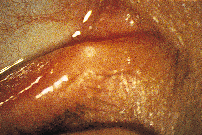Punctum plugs may enhance glaucoma therapy
BIRMINGHAM, Ala.—A pilot study designed to determine if there is a beneficial effect in using punctum plugs to improve glaucoma therapy found that patients with Freeman-style plugs maintained a 1- to 2-mm Hg greater reduction in intraocular pressure (IOP) during a 12-hour period vs. patients with no plugs.
 --- Jimmy D. Bartlett, OD
--- Jimmy D. Bartlett, OD
"If you can maintain a 2-mm Hg difference over long periods of time in a majority of glaucoma patients, that might be clinically significant," said Jimmy D. Bartlett, OD, lead investigator and professor of optometry and pharmacology here at the University of Alabama at Birmingham Schools of Optometry and Medicine. "If you look at some of the laser studies investigating laser trabeculoplasty, there's excitement about 0.5- to 1-mm Hg differences, so a 2-mm Hg difference would be significant."
According to Bartlett, the trial was a multicenter, double-masked, randomized study comparing IOP in 17 patients during two separate 12-hour sessions. In each session, half of the patients had punctum plugs and half did not. Those who had plugs the first time did not have them during the second session.
All participants were either being treated for glaucoma or had ocular hypertension and met the entry criteria of an IOP of at least 23 mm Hg without treatment. The baseline IOP before treatment and after 2 weeks of washout with no medication averaged 25 mm Hg, Bartlett said.
Neither the patients nor investigators knew who had plugs inserted during the trial, he said, because a third party checked the tonometer readings and inserted the plugs. "Investigators did not know what to anticipate in terms of pressure response," Bartlett said.
Freeman-style punctum plugs were chosen for the study, he said, because they are inserted flush to the lid margin and are easy to monitor and remove.
Meaningful differences
 --- Complications easily monitored: Glaucoma patients are seen every 3-6 months, giving practitioners plenty of opportunity to monitor the possibility of infection or a missing plug.
--- Complications easily monitored: Glaucoma patients are seen every 3-6 months, giving practitioners plenty of opportunity to monitor the possibility of infection or a missing plug.
Investigators used 0.25% timolol maleate (Timoptic, Merck) as the active agent during the trial. Before inserting the plugs and administering one drop of timolol in each eye, patients had their pulse rate, blood pressure and IOP checked. These readings were rechecked at intervals of 1, 2, 4, 8 and 12 hours.
"We found that the largest difference between the patients who had plugs and those who did not was at 4 hours," Bartlett said. Four hours into the study, patients who did not have plugs had an IOP of 18 mm Hg, while those with punctum plugs recorded 16 mm Hg.
At 8 hours the IOP was recorded at 18 mm Hg in the group without plugs, and 17 mm Hg in the group with plugs. At 12 hours, IOP in the group without plugs measured 19 mm Hg and 18 mm Hg in patients who had punctum plugs.
"There was meaningful difference all the way through to 12 hours," Bartlett said. "If we'd had a larger number of patients, 50 or 100, we might have been able to show statistical significance as well."
Therapy enhancement
What these results do indicate, he continued, is that using punctum plugs in glaucoma patients may give practitioners an objective, cost-effective alternative to laser treatment.
"You could start a patient on normal drop therapy, and if you are not achieving the results you'd hoped, maybe you'd use plugs before deciding to do a surgery that has risks and cost associated with it," Bartlett said.
Bartlett said the study results are being submitted for publication, and they could change the way optometrists approach glaucoma management now. "We tell our glaucoma patients to do manual nasolacrimal occlusion. They have to put the drops in and put their fingers in the inner corner of the eye for 3-5 minutes," he said. "A lot of patients aren't compliant and won't or can't do it."
This aspect of management can be even more difficult for the typically elderly glaucoma patients who could also suffer from arthritis, are unable to perform the technique or do not understand what the OD wants them to do.
"But if we can do something that's more objective, like insert a plug, then the patients put the drop in and go," he said. "It's a much more satisfactory way to potentially treat glaucoma. Many of our patients who are older and have dry eye have plugs anyway, so if you have a glaucoma patient who had dry eye, you might treat the dry eye with a plug and that plug might inherently have a beneficial effect on the patient's glaucoma therapy."
Bartlett said any potential drawbacks to punctum plugs—possible infection of the lacrimal drainage system, expulsion of the plug or ocular irritation—could be easily monitored because glaucoma patients are seen every 3-6 months, whereas dry eye patients are usually not seen as often.
"There are potential problems with plugs that we'd want to observe in longer-term studies, but we're pretty encouraged by these results. The next step would be to do a larger, longer study," he said.
